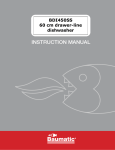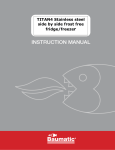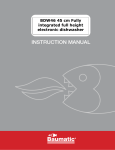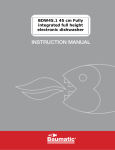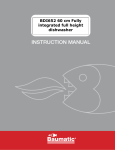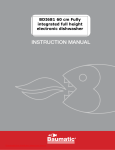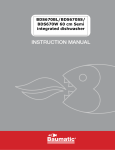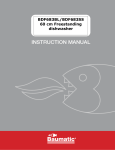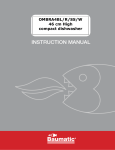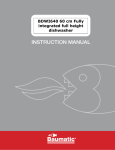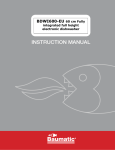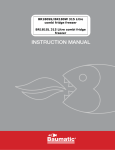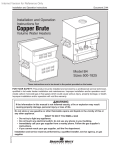Download Baumatic BDI450SS User manual
Transcript
BDI450SS 60 cm drawer-line dishwasher USER MANUAL FOR YOUR BAUMATIC BDI450SS 60 cm drawer-line dishwasher NOTE: This User Instruction Manual contains important information, including safety & installation points, which will enable you to get the most out of your appliance. Please keep it in a safe place so that it is easily available for future reference; for you or any person not familiar with the operation of the appliance. GS 27/10/10 2 Contents Environmental note 4 Important safety information 5–7 Specifications Product and aperture dimensions Product specifications Electrical details Description of the appliance Control panel 8 – 11 8 8-9 9 10 11 Using your dishwasher Before first use Filling with dishwasher salt Filling with rinse aid Setting the rinse aid level Filling with dishwasher detergent Concentrated detergent Detergent tablets Loading the basket The cutlery basket Loading dishes and cutlery Program table Setting a wash program Changing the wash program Adding more dishes Setting a delay start At the end of a wash cycle 11 11 11 13 14 14 15 15 16 18 19 20 21 22 22 23 23 Cleaning and maintenance The filter system Cleaning the filters Cleaning the spray arm Cleaning the control panel Cleaning the door Cleaning the door gasket Not using the appliance for prolonged periods? Reconnecting the appliance after a period of disuse 24 -27 24 25 25 -26 26 26 26 26 -27 27 Installation Installing the dishwasher into a kitchen cabinet Positioning the appliance Installing the aesthetic panel Placing the dishwasher Connecting to the mains water supply Water outlet Power supply Before first use 27 28 29 29 32 33 34 35 36 Troubleshooting Error codes 37 -39 39 Contact details 40 -23 -12 -15 -17 -20 -21 -22 -23 -36 -29 -31 -33 -35 -36 3 Environmental note o The packaging materials that Baumatic uses are environmentally friendly and can be recycled. o Please discard all packaging material with due regard for the environment. 4 IMPORTANT SAFETY INFORMATION Your safety is of the utmost importance to Baumatic. Please make sure that you read this instruction booklet before attempting to install or use the appliance. If you are unsure of any of the information contained in this booklet, please contact the Baumatic Advice Line. General Safety o Repairs to your appliance must only be carried out by a Baumatic engineer or one of its authorised service agents. Any attempt by an inexperienced person to repair the appliance, could result in injury or damage to your dishwasher. o If you notice that the mains cable is damaged. The appliance must not be used. The same applies if you notice that the worktop, control panel or base area is damaged. As this could allow access to the internal components of the machine. o The appliance should be turned off and isolated from the mains supply, before either cleaning or maintenance work is attempted. o The mains cable must not be used to pull the plug out of the electrical socket. o The machine should not be sprayed with water. o The external surface of the appliance may become hot whilst your dishwasher is in use. o It is possible for small animals to chew either mains cables or water hoses, which could cause an electric shock hazard. Installation o The installation instructions contained within this user manual should be followed. o It is obligatory for the completed installation to comply with all relevant building regulations and local water authority requirements. o Before the first use of the appliance, you should follow the steps listed in the “Before first use” section of this manual. 5 o Care should be taken not to trap the power supply cable underneath the appliance whilst installing it. o No attempt should be made to alter or modify the specifications of this appliance. In daily use o This appliance is only designed to wash normal domestic wash loads. If you use your dishwasher in any other way or it is incorrectly used, then Baumatic accepts no liability for any damage that might be caused and any guarantee will be void. o It is recommended that the appliance is unplugged and the water supply is turned off after the machine is used. o The detergents, rinse aid and salt that you place in this appliance should be suitable for automatic dishwashers. With regards to dosage levels, the detergent manufacturer’s recommendations should be followed. o Sharp knives or ones with long blades are a potential safety hazard when placed in an upright position in the cutlery basket. We would recommend that these items are placed horizontally in the main basket. o You should not wash any items that have come into contact with corrosive, acidic or alkaline chemicals, paint, petrol, iron or steel debris. o You should not open the door whilst the appliance is set on a wash program. Depending on which stage that the wash program is at, hot water could escape the machine. o You should not leave the door of the appliance open, unless you are loading or unloading the dishwasher. o You should not stand or sit on the door when it is open. 6 Child Safety o Your dishwasher should only be used by adults. You should not allow children in the area of the machine unsupervised. You should not let them touch the controls or play with the appliance. o It could be possible for a child or pet to gain access to the dishwasher if the door is left open. Therefore please check the inside of the appliance before setting it on a wash cycle. o Any packaging that is removed from the machine should be kept away from children. o All detergents should be kept out of children’s reach in a safe place. o Some water will remain inside the dishwasher when it has completed a wash cycle. This water is not suitable for drinking and may contain residues from the detergents that are used in the appliance. Declaration of conformity This appliance complies with the following European Directives: -73/23 dated 19/02/1973 Low Voltage Directive and subsequent modifications. -89/336 dated 03/05/1989 Electromagnetic Compatibility Directive and subsequent modifications. For future reference please record the following information which can be found on the rating plate and the date of purchase which can be found on your sales invoice. The rating plate of your dishwasher is located on the right hand side of the drop down door. Model Number ………………………………. Serial Number ………………………………. Date of Purchase ………………………………. 7 Specifications Product and aperture dimensions Product dimensions Aperture dimensions Height: Width: Depth: Height: Width: Depth: 475 mm 590 mm 500 mm 443 mm 555 mm 550 mm Product specifications o 6 Place settings 6 functions: Normal Intensive Economy Rapid Glass 1 hour o 6 Wash temperatures: 40°C, 45°C, 55°C, 60°C, 65°C, 70°C 8 o o o o o o o o o o Delay start LED display Anti-leak device Anti-flood device Self-cleaning stainless steel micro-filter Concealed heating element Adjustable feet Wash phase indicator Salt light indicator Rinse aid light indicator o Low water consumption (8 litres) o Noise level (52 dB) Energy efficiency details Energy efficiency class: A Washing performance class: A Drying performance class: A Electrical details Rated voltage: Maximum rated input: Supply connection: 230 Vac 50 Hz 1.28 kW 3.15 A (double pole switched fused outlet with 3 mm contact gap) 9 Description of the appliance Dishwasher features 1) Salt container 2) Detergent dispenser 3) Cutlery basket 4) Filter assembly 5) Rinse aid dispenser 6) Spray arms 7) Cup shelf 8) Basket 9) Drain pipe connector 10) Inlet pipe connector 10 Control panel 1) 2) 3) 4) 5) 6) 7) Power indicator light and switch. Salt warning indicator Rinse aid warning indicator Delay start button and LEDS Delay start indicator Program button Program indicator LEDS Using your dishwasher Before first use o Install the appliance as per the installation instructions contained within this booklet. o Fill the water softener with 1 litre of tap water and then fill with specialist dishwasher salt. After this you should set the water softener level. o Fill the rinse aid dispenser and then set the rinse aid dosage. Filling with dishwasher salt IMPORTANT: You should only use salt that is specially designed for use in a dishwasher. If any other type of salt is used in the appliance (in particular table salt), it will damage the water softener. o Ideally you should fill the water softener with salt, just before you are about to run a wash program. This will help to clear any salt that may have overflowed from the water softener during the salt filling process. o Open the door of the dishwasher and remove the basket. The basket should be empty when you remove it. o Turn the water softener cap anticlockwise and remove it (1). o Pour 1 litre of water into the water softener. IMPORTANT: It is only necessary to do this when you fill the container with salt for the first time. o Ensure that the supplied funnel is positioned correctly. o Pour salt into the water softener, you should add approximately 1 kg of salt into the water softener (2). o It is perfectly normal for a small amount of water to come out of the water softener, whilst you are filling it with salt. This does not mean that the water softener is filled with the correct amount of salt. o Refit and fully tighten the water softener cap. o To remove any excess salt that may have spilled out of the water softener, we would recommend that the RAPID wash program is completed afterwards. o When the salt required neon (2) lights on the control panel, then you should follow the “filling with dishwasher salt” procedure again. o IMPORTANT: You do not need to pour 1 litre of water into the container when you subsequently fill the water softener with salt. 12 Filling with rinse aid The rinse aid is released during the final rinse and it helps to prevent water from forming droplets on your dishes. These droplets will lead to spots and streaks being left on items after the wash program has completed. o Your dishwasher is designed to utilise liquid rinse aid. o The rinse aid container is located on the inside of the dishwasher door next to the detergent dispenser. o To access the rinse aid dispenser, you should turn and remove the cap to reveal the spout (1). o Slowly pour in liquid rinse aid, the rinse aid dispenser will hold approximately 110ml of rinse aid (2). o You should continue to fill with rinse aid until the level indicator turns completely black. Be careful not to overfill the dispenser, as this could cause oversudsing when a wash program is selected. Wipe away any rinse aid excess or spillages with a damp cloth. o Replace the cap and turn it until it locks into position (3). o When the rinse aid required neon (3) lights on the control panel, then you should follow the “filling with rinse aid” procedure again. 13 Setting the rinse aid level The amount of rinse aid that the dishwasher requires also depends on the hardness of your water. You should experiment with the rinse aid setting, until you find a level that gives the best results. o Use the dial, located on the rinse aid dispenser, to set the level. o You should always start with the dispenser set on level 4. If you find spots on your dishes or the drying results are poor, increase the amount of rinse aid by rotating the dial to level 5. o You can increase or decrease the level according to individual needs and results. Filling with dishwasher detergent The detergent dispenser must be refilled at the start of each wash cycle. o Your dishwasher uses less detergent and rinse aid than a conventional dishwasher. Generally, only one tablespoon of detergent is needed for a normal wash load. o Press the release button to open the detergent compartment (1). o Pour in the required amount of detergent into the main compartment and the pre-wash compartment if needed (2). The pre-wash section can be filled if the dishes are heavily soiled. 14 A = Main wash cycle detergent B = Pre-wash cycle detergent o Close the lid and press gently until it locks into place. Concentrated detergent o The use of the NORMAL washing program, in conjunction with concentrated detergents, reduces pollution and is good for your dishes. o This wash program is specifically matched to the dirt-dissolving properties of the enzymes of the concentrated detergent. For this reason, the NORMAL wash program, in which concentrated detergents are used, can achieve the same results as the INTENSIVE program. Detergent tablets o Detergent tablets of different brands dissolve at different speeds. For this reason, some detergent tablets cannot dissolve and develop their full cleaning power during short programs. o Therefore, longer programs should be selected when using detergent tablets to ensure the complete removal of detergent residues. 15 Loading the basket The appropriate way to load the basket is shown in the picture below. 1 Cups 2 Medium serving bowls 3 Glasses 4 Saucers 5 Dishes 6 Oval platters 7 Dinner plates 16 8 Soup plates 9 Dessert dishes 10 Cutlery basket o The basket is fitted with plate racks which can be stowed horizontally if required. o The cup shelf can be rotated upwards if no cup is placed on it to make more space in the basket. o Saucepans and serving bowls must always be placed with their bases upwards. o Deep saucepans should be slanted, to allow water to run off. IMPORTANT: Care should be taken to make sure that the spray arm can move freely when items have been loaded into the basket. 17 The cutlery basket Cutlery should be placed inside of the cutlery basket. The cutlery basket should then be placed in the appropriate position in the basket. 1 Forks 2 Soup spoons 3 Dessert spoons 4 Teaspoons 5 Knives 6 Serving spoons 7 Ladles 8 Serving forks IMPORTANT: Do not allow items of cutlery to fall through the bottom of the cutlery basket, as this may cause damage to the spray arm and/or the cutlery. If the bottom of the basket begins to deteriorate and allows items to fall through, you should replace the cutlery basket. 18 Loading dishes and cutlery Household cloths, sponges or any other object that may absorb water SHOULD NOT be washed in a dishwasher. o Remove leftovers and soften the remnants of burnt food in pans, prior to loading dishes in the appliance. o Once the dishwasher has been loaded, check that the spray arm can move freely. If the spray arm comes into contact with any item, then you should rearrange the wash load. o Cups, glasses, pans etc should all be loaded with their bases upwards, so that water does not collect inside of them. o Cutlery and dishes should not cover each other; otherwise you may get poor wash results. o Do not allow glasses to touch inside the dishwasher, otherwise damage may occur. o Small objects can be placed inside of the cutlery basket. o Sharp knives or ones with long blades are a potential safety hazard when placed in an upright position in the cutlery basket. We would recommend that these items are placed horizontally in the main basket. The following items are NOT suitable for washing inside a dishwasher:o Cutlery with a handle of mother-of-pearl, wood, horn or china. o Plastic items that are not resistant to heat. o Cutlery that consists of glued parts that are not resistant to heat. o Cutlery items or crockery that are bonded. o Copper or pewter items. o Lead crystal glass. o Wooden platters. o Synthetic fibre items. 19 The following items are not always suitable for washing inside a dishwasher:o Stoneware should only be washed if the manufacturer of the item has marked it as dishwasher safe. o Plastic items (such as lunchboxes) should only be washed if the manufacturer has marked it as dishwasher safe. o Glazed crockery may fade with repeated washing inside of a dishwasher. o Items made of silverware or aluminium can discolour when washed inside a dishwasher. o Any food residue should be removed from silver immediately, as this can also result in discolouration. items o Certain types of glass may become dull or cloudy after a large number of washes. Program table Program Intensive Normal Cycle selection information For the heaviest soiled loads, such as pots, pans, casserole dishes and dishes that have been sitting with dried food on them for a while. For normally soiled loads, such as pots, plates, glasses and lightly soiled pans. A standard daily cycle. Description of cycle Pre-wash (50°C) Wash (70°C) Rinse Rinse Rinse (70°C) Drying Pre-wash Wash (60°C) Rinse Rinse (70°C) Drying Detergent Pre/main 3/15 g 3/15 g Running time (min) 145 minutes (2:25 hours on display) 125 minutes (2:05 hours on display) Energy (Kwh) Water (L) 0.94 10.7 0.70 8.7 Rinse aid 20 Economy* Glass 1 hour Rapid For lightly soiled loads, such as plates, glasses, bowls and lightly soiled pans. For lightly soiled loads, such as glasses, crystal and fine china. 1 hour wash for lightly soiled loads that do not need drying. A shorter wash for lightly soiled loads that do not need drying. Pre-wash Wash (55°C) Rinse Rinse (70°C) Drying Wash (45°C) Rinse Rinse (60°C) Drying Wash (65°C) Rinse Rinse (50°C) Drying Wash (40°C) Rinse Rinse 3/15 g 15 g 15 g 170 Minutes (2:50 hours on display) 75 Minutes (1:15 hours on display) 60 (1 hour on display) 15 30 0.63 8.4 0.48 6.8 0.30 6.8 0.30 5.8 *EN 502-42. This program is the test cycle. Setting a wash program Make sure that the “Before first use” section has been followed. o Pull out the basket and then load it in accordance with the loading instructions. o Push the basket fully back into position. o Pour detergent into the relevant compartments accordingly. o Make sure the water supply is turned on to full pressure. o Press the power switch (1) to switch the machine on, the power indicator light will turn on. o Check whether the salt required icon (2) or rinse aid required icon (3) are lit. If they are, then before continuing with the wash program you should fill the dishwasher with salt and/or rinse aid. o Press the program selection button (6) until the relevant program indicator (7) lights to make your selection. The programs will scroll in the following order: 21 Intensive Æ Normal Æ Eco Æ Glass Æ 1 hour Æ Rapid o Close the dishwasher door and ensure it is securely shut. After 10 seconds the washing cycle will being. IMPORTANT: When you open the dishwasher door to pause the cycle, the program light will stop blinking and the dishwasher will emit an acoustic signal every minute until the door is closed again. Changing the wash program o If a cycle has only been running for a short time, then it can still be modified. Otherwise, the detergent may have already been released and the appliance may have already drained the wash water. o Once the wash cycle is in full progress, we do not recommend that you attempt to change the wash program. o However if you do wish to do this, you should open the door a little way to stop the cycle. o Press and hold the program selection button (6) for about 3 seconds to cancel the current program. o You can then select another program as before, using the program selection button (6). o IMPORTANT: If you open the door during a wash cycle, the machine will pause. When you close the door again, the machine will continue the cycle after approximately 10 seconds. Adding more dishes o A forgotten dish can be added any time at the start of a wash cycle before the detergent is released. o To do so you should open the dishwasher door a little way to pause the program. o After the spray arms have stopped working you can then open the door completely. o Introduce the additional dishes into the dishwasher. o Close the dishwasher door ensuring it is securely shut. 22 o After approximately 10 seconds the dishwasher will continue the washing program. Setting a delay start o You can delay the start of the washing cycle by programming the dishwasher to begin after 3, 6, 9 or 12 hours. o To program a delay start you should load the dishwasher according to the instructions in the “Setting a wash program” section. After loading the basket, filling the detergent compartment and selecting a program you should then set the delay start before closing the dishwasher door. o To do so, press the delay start button (4) repeatedly to scroll through the time options. When the required time delay is lit on the display you should release all button and then close the door. o The delay start indicator (5) will display the programmed time. At the end of a wash cycle o When the washing cycle is complete, a buzzer will sound for 8 seconds and then switch off. o Before opening the dishwasher door you should press the power switch (1) to turn the appliance off and shut off the water supply. o IMPORTANT: You should wait about 15 minutes before unloading the dishwasher to avoid handling the dishes and utensils while they are still hot and more susceptible to breakage. They will also dry better. o WARNING: Hot steam may escape when the door is first opened, so care should be taken. o It is normal for the dishwasher to be wet inside after a program. 23 Cleaning and maintenance IMPORTANT: The appliance should be disconnected from your mains supply before commencing any cleaning process. The filter system Your appliance is fitted with three levels of filtering; these are located in the base of the dishwasher for ease of access. 1) Main filter 2) Fine filter 3) Coarse filter Main filter- Food and soil particles are trapped by this filter and pulverised by a special jet on the lower spray arm. This debris is then washed down the drain. Fine filter- This filter holds soil and food residue in the sump area and prevents it from being redeposited on the dishes during a wash cycle. Coarse filter- Larger items such as pieces of bone or glass, which could clog the drain, are trapped in this filter. IMPORTANT: Whilst the filtering system is efficient, your dishwasher is not a waste disposal unit. All items being washed inside of the dishwasher should have food scraps removed from them before being loaded into the appliance. 24 Cleaning the filters For best performance and results, the entire filter assembly should be thoroughly cleaned regularly (ideally after each wash cycle). o Remove the basket from the appliance. o Rotate the fine filter anti-clockwise and then lift it upwards. Rinse out this section under a tap to remove any food debris that remains in it. o Pull out the main filter and rinse this under the tap to remove any food debris that is trapped in it. o Place the fine filter back in its original position. o Place the main and coarse filter back into their original positions in the base of the dishwasher. You must turn the fine filter clockwise to lock it back into position. IMPORTANT: THE DISHWASHER SHOULD NEVER BE SET ON A WASH CYCLE WITHOUT THE FILTERS BEING INSIDE OF THE APPLIANCE. Cleaning the spray arm The spray arm can be easily removed for periodic cleaning of the nozzles to prevent possible clogging. o IMPORTANT: Remove the basket before attempting to remove the spray arm. 25 o Grasp the middle of the spray arm and pull it upwards to remove it. o Wash the arm under running water and carefully replace it in the dishwasher. o After reassembling the spray arm, check that it moves freely. Cleaning the control panel IMPORTANT: Do not use any abrasive cleaner or household polish on either the control panel or operating parts. o Wipe over the control panel using a brand new damp cloth with warm water. Cleaning the door o To clean the edge around the outside of the door, you should use a soft, damp cloth only. o To prevent water from penetrating the door lock or electrical components, DO NOT use a spray cleaner of any kind. o DO NOT use any abrasive cleaner or scouring pads on the inner or outer surfaces, as they may cause damage to them. Cleaning the door gasket o Use a damp sponge to clean the door gasket from time to time. This will prevent the build up of food residues which could cause unpleasant odours. Not using the appliance for prolonged periods? If the dishwasher is not going to be used for a prolonged period of time, then we would recommend that you do the following:o Fill the rinse aid dispenser. o Run one or two cycles with the dishwasher empty. 26 o Disconnect the electrical and water connections. o Leave the door ajar slightly to prevent an unpleasant odour from developing. o Clean all of the filters and dry the inside of the machine thoroughly. Reconnecting the appliance after a period of disuse If the appliance has not been used for a prolonged period of time, then before using the appliance again, we would recommend that you do the following:o Check that no sludge or rust has built up in the pipes. If this has happened, let water run through the tap for a few minutes. o Reconnect the inlet hose and outlet hose, making sure that the water tap is open. o Reconnect the appliance to your mains supply. Installation Installation of this appliance must be carried out by a suitably qualified person, in accordance with the current version of the following. o UK Regulations and Safety Standards or their European Norm Replacements. o Building Regulations (issued by the Department of the Environment). o Building Standards (issued by the Scottish Development Department). o IEE Wiring Regulations. o Electricity At Work Regulations. Before connecting the appliance, make sure that the supply voltage marked on the rating plate corresponds with your mains supply voltage. WARNING: THIS APPLIANCE MUST BE EARTHED. IMPORTANT: THIS INSTALLATION MUST BE COMPLETED BY A SUITABLY QUALIFIED PERSON. BAUMATIC ONLY SANCTION THE INSTALLATION GIVEN IN THIS INSTRUCTION MANUAL. YOU SHOULD 27 DISPOSE OF ALL PACKAGING FRIENDLY MANNER. IN AN ENVIRONMENTALLY Installing the dishwasher into a kitchen cabinet o Ensure that the aperture that you will be fitting the dishwasher into is of the size given in the diagram above. o Ensure that the rear panel of the furniture housing unit has been removed and that the ventilation cut out shown is adhered to. o You must ensure that there is a hole to feed the electrical cable through. There must also be holes left to connect the appliance to your mains water supply and to your drain outlet. These steps must be done before commencing the rest of the installation process. o IMPORTANT: The stop valve for your water supply MUST be easily accessible during an emergency. o Before proceeding with the rest of the installation, you must connect the inlet hose and the outlet hose to the rear of the appliance. See the relevant section of this manual. 28 o Feed the electrical cable, inlet hose and outlet hose through the holes in the housing unit that you made previously. Positioning the appliance o Ensure there is a minimum space of 50 mm in front of the dishwasher door. This will enable the door to be opened and closed freely with no obstructions. Installing the aesthetic panel 29 o The diagram above shows the require dimensions of the aesthetic panel. For a detailed diagram please see below. o You should drill the fastening holes in the panel, according to the diagram above. o The maximum weight of the aesthetic panel should be 3 – 4 kg. 30 o Assemble the aesthetic handle to the previously drilled holes and fix the lower brackets and hinge as in the diagram above. o Install the aesthetic door to the front of the appliance using the fixing screws as shown in the above image. 31 Placing the dishwasher o Carefully slide the dishwasher in the aperture cut-out. o Adjust the screw to balance the appliance and to ensure the aesthetic panel aligns with the cabinet. o Take out the cap, as shown in the above diagram, to reveal the fixing hole. 32 o Fix the screws on both sides to ensure the dishwasher cannot be moved from the cabinet. o Replace the cap. Connecting to the mains water supply IMPORTANT: Do not connect the appliance to your mains water supply using an old or an existing water inlet hose. The inlet hose supplied with the dishwasher is the ONLY one that should be used. o Connect the inlet hose to the inlet valve on the rear of the product. Please refer to the photographs above to see the correct position that the inlet hose should be in when connected. o Connect the water inlet hose to a threaded water tap that has a 3/4” thread. o Fully tighten the inlet hose to the water tap and the dishwasher. o The water supply to the appliance can also be connected to the house’s hot water line, or centralised heating system, as long as the temperature does not exceed 60°C at any time. o If the temperature exceeds this limit, the wash cycle length will be reduced and the efficiency of the appliance will be dramatically lower. o The connection to the hot water line can be made by following the same procedure as above for the cold water line. 33 Water outlet o Connect the drain hose to the rear of the appliance. o Insert the drain hose into the drain pipe with a minimum diameter of 4 cm. Alternatively you can let it run into the sink as long as you ensure it is not bent or crimped in the process. You should use the plastic support that comes with the appliance. o If the sink is 1000 mm above the floor, the excess water in the hose cannot be drained directly into the sink. It will be necessary to drain the excess water into a bowl or a suitable container that is held outside and lower than the sink. IMPORTANT: Do not insert the drain hose too deeply into the water pipe, as this may cause siphoning. o The free end of the hose must be at a height of lower than 75 cm and must not be immersed in water to avoid any back-flow. o The plastic hose support must be solidly fastened to the wall to prevent the drain hose from moving and allowing water to spill outside of the drain. 34 WARNING: NEVER EXTEND THE DRAINAGE HOSE FROM ITS ORIGINAL LENGTH. Power supply IMPORTANT: The electrical socket must still be accessible once the appliance is installed. o Consult the rating plate on the inside of the appliance before making the electrical connections. Ensure that the voltage reaching the plug is the same as that on the rating plate. DO NOT REMOVE THE RATING PLATE AS THE INFORMATION ON IT IS IMPORTANT. WARNING: THIS APPLIANCE MUST BE EARTHED. o If you are not going to use the plug that is fitted to the power cable, then the dishwasher should be wired into a 3.5 A double 35 pole switched fused spur outlet, having 3 mm contact separation and placed in an easily accessible position adjacent to the appliance. The spur outlet must still be accessible even when your dishwasher is located in its housing. o Broken or damaged power leads must only be replaced by a suitably qualified person. A power lead of a similar type must be used in replacement. IMPORTANT: We do not recommend that this appliance is connected to an extension lead. Before first use You should check the following before using the appliance for the first time:That the dishwasher is level and fixed in position. That the water tap is fully open. That there are no leaks at either end of the drain or inlet hoses. That the inlet and drain hoses are fully tightened. That the inlet and drain hoses are not kinked. That the power is switched on. That the water softener has been filled with 1 litre of water and filled with dishwasher salt. o That the rinse aid dispenser has been filled. o o o o o o o 36 Troubleshooting o If your appliance is not functioning as it should be, please consult the table below BEFORE calling the Baumatic Customer Care Advice Line. Problem Dishwasher does not start. Water not pumped from dishwasher. Suds in the tub. Stained tub interior. White film on inside surface. There are rust stains on cutlery. Knocking noise in the wash cabinet. Rattling noise in the wash Possible causes What to do Technical problems Fuse blown or the circuit Replace fuse or reset circuit breaker. breaker tripped. Remove any other appliances sharing the same circuit with the dishwasher. Power supply is not turned Make sure the dishwasher is turned on on. and the door is closed securely. Make sure the power cord is properly plugged into the wall socket. Door of dishwasher not Close dishwasher door making sure properly closed. that the door latches. Kink in drain hose. Check drain hose. Filter clogged. Check coarse filter (see “Cleaning the filter” section). Kitchen sink clogged. Check kitchen sink to make sure it is draining well. If the problem is the kitchen sink not draining, you may need a plumber rather than a service engineer for the dishwasher. General problems Improper detergent. Use only the special dishwasher detergent to avoid suds. If this occurs, open the dishwasher and let the suds evaporate. Add 1 gallon of cold water to the tub. Close and latch the door then start the RAPID wash to drain out the water. Repeat if necessary. Spilled rinse-aid. Always wipe up rinse-aid spills immediately. Detergent with colourant Make sure that the detergent is one was used. without colourant. Hard water minerals. To clean the interior, use a damp sponge with dishwasher detergent and wear rubber gloves. Never use any other cleaner than dishwasher detergent for the risk of foaming or suds. The affected items are not corrosion resistant. A program was not run Always run the RAPID wash program after dishwasher salt was without any crockery in the dishwasher added. Traces of salt have after adding dishwasher salt. got into the wash cycle. The lid of the softener is Check the lip and ensure the fix is fine. loose. Noise The spray arm is knocking Interrupt the program and rearrange against an item in the the items which are obstructing the basket. spray arm. Item of crockery is Interrupt the program and rearrange insecure in the wash the items of crockery. 37 cabinet. Knocking noise in the water pipes. The dishes are not clean. Cloudiness on glassware. Black or grey marks on dishes. Detergent left in dispenser cups. The dishes are not drying. cabinet. This may be caused by This has no influence on dishwasher on-site installation or the function. If in doubt, contact the cross-section of the Customer Care Advice Line. piping. Unsatisfactory washing result The dishes were not See the “Loading the dishwasher” loaded correctly. section. The program was not Select a more intensive cycle. powerful enough. Not enough detergent was Use more detergent or change your dispensed. detergent. Items are blocking the Rearrange the items so that the spray path of the spray arm. arm can rotate freely. The filter combination in Clean and / or fit the filter combination the base of the wash correctly. Clean the spray arm jets. See cabinet is not clean or is “Cleaning the spray arm” section. not correctly fitted. This may cause the spray arm jets to get blocked. Combination of soft water Use less detergent if you have soft and too much detergent. water and select a shorter cycle to wash the glassware and to get them clean. Aluminium utensils have Use a mild abrasive cleaner to rubbed against dishes. eliminate the marks. Dishes blocking detergent cups. Re-load the dishes properly. Unsatisfactory drying result Improper loading. Load the dishwasher as suggested in the directions. Too little rinse-aid. Increase the amount of rinse-aid or refill the rinse-aid dispenser. Dishes are removed too Do not empty the dishwasher soon. immediately after washing. Open the door slightly so that the steam can escape. Begin unloading the dishwasher only once the dishes are barely warm to the touch. Wrong program selection. In short programs the washing temperature is lower. This also lowers cleaning performance. Choose a program with a long washing time. Using cutlery with a lowWater drainage is more difficult with quality coating. these items. Cutlery or dishes of this type are not suitable for washing in the dishwasher. 38 Error codes o When some malfunctions occur, the appliance will display an error code to warn you. Codes The RAPID light flickers. The ECO light flickers. Meanings Longer inlet time. Overfilled. Possible causes Tap is not opened or water intake is restricted or water pressure is too low. Too much inlet water or some element of the dishwasher leaks. IMPORTANT: If any other fault code appears on the LED display or the same fault code reoccurs, you should not attempt to clear it yourself and contact the Baumatic Customer Care Department. IMPORTANT: If your appliance appears not to be operating correctly, then you should disconnect it from your mains supply and then contact Baumatic Customer Care on telephone number (0118) 933 6911. DO NOT ATTEMPT TO REPAIR THE APPLIANCE YOURSELF. Please note that if an engineer is asked to attend whilst the product is under guarantee and finds that the problem is not the result of an appliance fault, then you may be liable for the cost of the call out charge. The appliance must be accessible for the engineer to perform any necessary repair. If your appliance is installed in such a way that an engineer is concerned that damage will be caused to the appliance or your kitchen, then he will not complete a repair. This includes situations where appliances have been tiled in, sealed in with sealant, have wooden obstructions placed in front of the appliance, like plinths. Or any installation other than the one specified by Baumatic Ltd. has been completed. Please refer to the conditions of guarantee that appear on the warranty card that you receive with the appliance. IMPORTANT: Baumatic Ltd. operates a policy of continuous improvement and reserves the right to adjust and modify its products without prior notification. 39 United Kingdom Baumatic Ltd., Baumatic Buildings, 6 Bennet Road, Reading, Berkshire RG2 0QX United Kingdom Czech Republic Baumatic CR spol s.r.o. Průmyslová zóna Sever 696 460 11 Liberec 11 Czech Republic Sales Telephone (0118) 933 6900 Sales Fax (0118) 931 0035 Customer Care Telephone (0118) 933 6911 Customer Care Fax (0118) 986 9124 Spares Telephone (01235) 437244 Advice Line Telephone (0118) 933 6933 www.baumatic.cz E-mail: [email protected] [email protected] [email protected] [email protected] Website: www.baumatic.co.uk Republic of Ireland Service Telephone 1-890 812 724 Spares Telephone 091 756 771 +420 483 577 200 Slovakia Baumatic Slovakia, s.r.o. Galvániho 7/D Slovakia +421 255 640 618 Germany Baumatic Gmbh Lilienthalstrasse 1 320 52 Herford Deutschland +49 5221 694 99-0 www.baumatic.de Italy Baumatic Italia S.R.L. Via Galvani N.3 35011 Campodarsego (PD) +3904 9920 2297 www.baumatic.it Holland Baumatic Benelux B.V. Grindzuigerstraat 22 1333 MS ALMERE Nederland +3136 549 1555 www.baumatic.nl 40 41 42 43












































